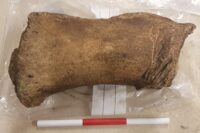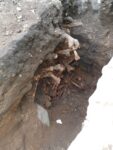 Two bones from a whale that may date as far back as the medieval period have been discovered in Leith, Scotland. Archaeologists surveying the site of a new tramway unearthed the rare bones earlier this year between the post office and a scrap yard on Constitution Street. They are the radius and ulna from the fin of a large adult male sperm whale and are a matched pair. They have not been radiocarbon dated yet because a pandemic rudely got in the way, but the archaeological context suggests they could be as much as 800 years old, dating to the earliest days of Leith’s settlement.
Two bones from a whale that may date as far back as the medieval period have been discovered in Leith, Scotland. Archaeologists surveying the site of a new tramway unearthed the rare bones earlier this year between the post office and a scrap yard on Constitution Street. They are the radius and ulna from the fin of a large adult male sperm whale and are a matched pair. They have not been radiocarbon dated yet because a pandemic rudely got in the way, but the archaeological context suggests they could be as much as 800 years old, dating to the earliest days of Leith’s settlement.
Located at the mouth of the Leith river on the Firth of Forth coast just north of Edinburgh, Leith has served as the city’s major port since the 12th century. Shipbuilding and whaling were two of its major industries from inception, the latter continuing well into the 1960s when ships had to go far afield to Arctic and Antarctic waters to find any whales left to kill.
Amongst possible theories are that they were brought back in the 19th or 20th century as a memento as part of Leith’s historic whaling industry, that they came from the remains of a whale beached locally and were subsequently dumped there or that they were part of medieval deposits left there during the reclamation of the site in the 17th to 19th centuries, perhaps dating back to the medieval period.
 Other finds of note made during the exploration include an iron cannonball likely dating to the 17th century when the defenses of this area of Leith were reinforced during the Civil War, the remains of large stone wall that may have been part of a seawall built in the 16th or 17th century.
Other finds of note made during the exploration include an iron cannonball likely dating to the 17th century when the defenses of this area of Leith were reinforced during the Civil War, the remains of large stone wall that may have been part of a seawall built in the 16th or 17th century.
When the archaeological work began in November 2019, the team took down a wall from a graveyard that was established on the site in 1790 and  in so doing discovered a large charnel pit with tightly stacked bones. This was probably created when graves were disturbed during the construction of utilities on Constitution Street in 19th century. The graveyard itself will be excavated later this year.
in so doing discovered a large charnel pit with tightly stacked bones. This was probably created when graves were disturbed during the construction of utilities on Constitution Street in 19th century. The graveyard itself will be excavated later this year.
City archaeologist John Lawson said: “Our work to excavate the area as part of preparatory work for the Trams to Newhaven project has offered really interesting glimpses into the area’s history, over the past three to four hundred years, and we’re endeavouring to conserve that.
“Discoveries like the whale bones have been particularly fascinating and exciting. These bones provide a rare glimpse into and also a physical link with Leith’s whaling past, one of its lesser known maritime industries and one which in the 20th century reached as far as the Antarctic. Given the circumstances of how they were found it is possible that they may date back to the medieval period, and if so would be a rare and exciting archaeological discovery in Edinburgh.”
In the end, the bones of the whales and whalers slept and were disturbed in the same soil.
It is interesting to consider that those human bones could have been built partly from the consumption of the whale.
Trevor, you mean inside the whale? The bones seem to have been piled up, though.
Meet “Leo”, the whale (who on Earth names his whale Leo? 😮 ) as the new, alternative ‘Altar Piece’ in Ghent, St. Bavo Cathedral.
That dead or half-dead whales –and whalers alike– are washed on European shores is not an entirely new phaenomenon. Quintus Metellus Celer received in 62BC, according to Pliny, “Indians” that allegedly had been picked up at the beaches, as a present from the chieftain of the Suebians.
——
“idem Nepos de septentrionali circuitu tradit Quinto Metello Celeri, Afrani in consulatu collegae, sed tum Galliae proconsuli, Indos a rege Sueborum dono datos, qui ex India commercii causa navigantes tempestatibus essent in Germaniam abrepti. sic maria circumfusa undique dividuo globo partem orbis auferunt nobis, nec inde huc nec hinc illo pervio tractu.”
LOL, inside the whale, you mean? Those bones seem to have been piled up – – Meet “Leo” the little whale (–who on Earth names his whale “Leo”?) as the new, alternative ‘Altar Piece’ in Ghent, St. Bavo Cathedral: pbs.twimg.com/media/DfWV6drX4AE_nsc.jpg
Dead or half-dead whales –and whalers alike– washed on European shores is not an entirely new phenomenon. Quintus Metellus Celer received in 62BC, according to Pliny, “Indians” that allegedly had been picked up on the beaches as a present from the chieftain of the Suebians.
The whale forearm with that cannonball :ohnoes:
——
“idem Nepos de septentrionali circuitu tradit Quinto Metello Celeri, Afrani in consulatu collegae, sed tum Galliae proconsuli, Indos a rege Sueborum dono datos, qui ex India commercii causa navigantes tempestatibus essent in Germaniam abrepti. sic maria circumfusa undique dividuo globo partem orbis auferunt nobis, nec inde huc nec hinc illo pervio tractu.”
aEWqgisRwOM